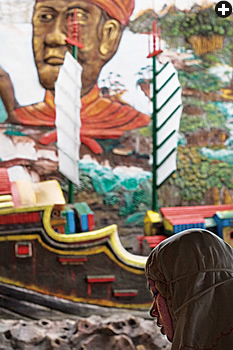 |
 |
 |
 |
 here are no official data on the Chinese Muslim population in Indonesia today, but a recent estimate suggests that slightly more than five percent of Chinese Indonesians are Muslims. (See lower chart, below.) Since ethnic Chinese themselves make up less than one percent of the country's population (middle chart), Chinese Muslims are a very small minority within a very small minority. Yet, because they share both the country's 88-percent majority religion (upper chart) and a heritage that goes back more than 600 years, they are, in the words of Cheng Hoo Mosque founder Hajji Muhammad Yusuf Bambang Sujanto, "a bridge" between Indonesian pribumi and the Chinese minority.
here are no official data on the Chinese Muslim population in Indonesia today, but a recent estimate suggests that slightly more than five percent of Chinese Indonesians are Muslims. (See lower chart, below.) Since ethnic Chinese themselves make up less than one percent of the country's population (middle chart), Chinese Muslims are a very small minority within a very small minority. Yet, because they share both the country's 88-percent majority religion (upper chart) and a heritage that goes back more than 600 years, they are, in the words of Cheng Hoo Mosque founder Hajji Muhammad Yusuf Bambang Sujanto, "a bridge" between Indonesian pribumi and the Chinese minority.
There were Chinese Muslims living in Java, Sumatra and elsewhere when Zheng He's fleet called at Java and Palembang in 1413. A century later, in 1513, Portuguese traveler Tomé Pires visited Java and noted in his travel account that foreign Muslims tended to become Javanese and Javanese tended to become Muslims. The rulers along the coastal areas, he wrote, were "not Javanese of long standing," but rather descendents of Chinese, Persians and other immigrants.
A 17th-century chronicle from Banten led the Dutch historians H. J. de Graaf and Theodore G. Th. Pigeaud to believe that the ancestor of the rulers of Demak, Java's first Islamic kingdom, was Chinese.
It was in the 17th century that the Dutch United East India Company (Vereenigde Oost-Indische Compagnie, or voc) began extending its influence over the Indonesian archipelago. It encouraged Chinese immigration at a time when events in China made this attractive. The men who came were mainly traders and laborers.
In 1740, following a decline in the sugar trade, the voc closed mills in Jakarta, and unemployed Chinese from the countryside revolted. In retaliation, the voc massacred some 10,000 of the 15,000 Chinese resident in Jakarta in what became known as "the Chinese Murder."
In the aftermath, many Chinese posed as natives, and this often meant a conversion to Islam. Several historic mosques in Jakarta date from this period. The voc tried to limit these conversions, in part because Chinese paid higher taxes than natives, but to little avail.
Chinese conversion to Islam was not limited to Jakarta, however. In fact, by the 18th century, peranakan communities had become well entrenched in most major towns across Indonesia. Australian historian Heather Sutherland's study on Makassar, for instance, shows that in the 18th century around one-third of Makassar's Chinese population were Muslims.
It was only in the 19th century, after the voc was replaced by direct Dutch government control, that segregation became official. In 1854, the government gave Europeans the highest status; the Chinese were categorized below the Europeans, alongside Arabs and Indians, as "Foreign Orientals," and the natives (pribumi) were given the lowest status. This "divide and conquer" strategy was guided by Dutch fears that Chinese and pribumi might work together against them.
 |
 |
At the end of World War ii, Indonesia found itself in a long and bitter revolution against the Dutch, and in 1950 it became formally independent. Sukarno, the first president, included Chinese Muslims in his cabinet as ministers of health and finance.
Coming to power in 1965, Indonesia's second president, Suharto, strongly favored assimilation and rejected the idea that Muslim and Chinese identities could co-exist. Javanese historian Slamet Muljana's 1968 book History of the Fall of Hindu Kingdoms in Java and the Rise of Islamic Sultanates in Indonesia, which advanced the idea that the Chinese were partly responsible for bringing Islam to Java, was banned, along with other accounts that attributed Chinese ancestry to some of the wali songo, the nine mythical saints believed to have brought Islam to Java.
As a result of these policies, according to Natalia Soebagjo, vice-chair of the Centre for Chinese Studies at the University of Indonesia, Indonesian Chinese today have few or no ties to Chinese culture or history. "They identify themselves as Indonesians, but it is often the indigenous Indonesians who remind them or point out to them that they are in fact Chinese."
After the fall of Suharto in 1998, the situation of the Chinese Indonesians improved. Abdurrahman Wahid, the fourth president (1999-2001), "made the difference by coming forth and claiming Chinese ancestry," observes Ivan Sasongko—specifically descent from a Chinese Muslim from Fujian Province who served as an ambassador in east Java during the Ming Dynasty.
In 2000, Wahid also reinstated the cultural and religious rights of the Chinese. Since then, Chinese organizations and Mandarin education have been revived, Chinese New Year is a public holiday and the Chinese press has reemerged. Chinese Muslims have found in the Ming admiral Zheng He a cultural symbol, says political scientist Leo Suryadinata, who shows that there is no need to discard ethnicity when embracing Indonesia's majority religion.
 |
Writer and photographer Zhuang Wubin (www.last-harbour.com) uses documentary photography to understand Chinese communities in Southeast Asia. Resident in Singapore, he has published photographs in The Asian Wall Street Journal, Post magazine of Hong Kong, Rhythms Monthly of Taiwan and at www.zonezero.com. |